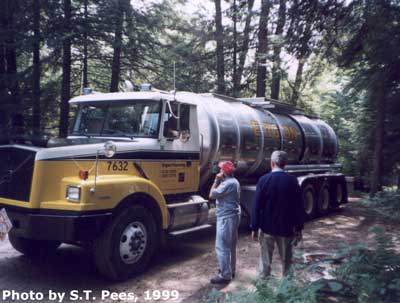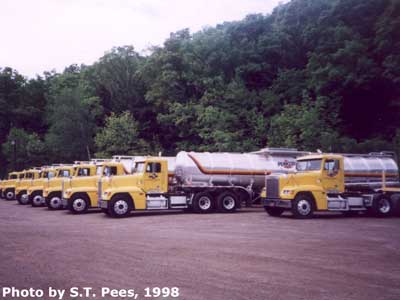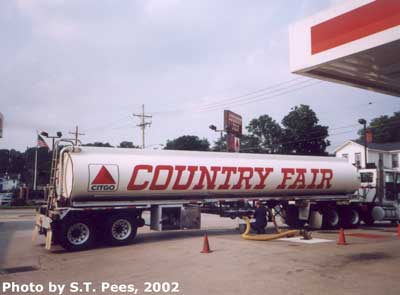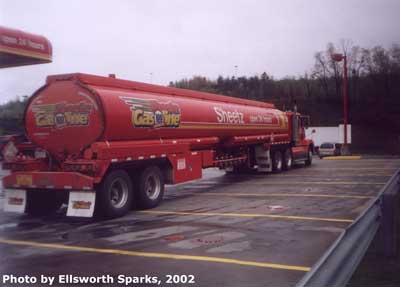|
|
World War II
The outbreak of WW II in the early 1940’s on two fronts (Europe and the Pacific) put an incredible demand on the oil refining and transportation capability of the domestic United States. Practically every means of transportation of crude and product was pressed into a magnitude of service heretofore unseen in this country and equally so in other countries that had oil production and refining plants. Pipelines, RR tank cars, ocean tankers, lake tankers (Great Lakes), river barges, canals (e.g. Barge Canal), tank trucks, air and sea refuelers and air cargo (e.g. "over the Hump") were in use around the clock. In France the famed truck convoy known as the Red Ball Express manned mostly by African American drivers hauled drums of motor oil, grease and gasoline at breakneck speeds in a bumper-to-bumper line.
Tank trucks in the U.S. and in liberated countries abroad became an essential link in the streams of gasoline and other refined products that were ultimately directed to the war fronts. Also to be reckoned was the need for home and factory heating oil and 80 octane (standard) motor gasoline that had to be met to keep the domestic work force on their shifts. The short haul was the tank trucks’ main contribution in the U.S., and this was defined by the Petroleum Administration for War (PAW) as 200 miles, although it started out less, 25 miles, then 100, finally 200. Tank trucks supplied aviation gasoline to the airfields, met fuel shortages at cities and in the nations’ capital and distributed products to retailers. It was estimated that they freed up 25,000 railway tank cars during the war (Frey and Ide, 1946). Local deliveries were the order-of-the-day for tank trucks.
In order to get more truck tankage on the roads, attempts were made to have loading and unloading on a 7 day per week, 24 hour per day basis (Curtin, 1946). If they weren’t at the tanks, they were on the road around the clock until VJ Day (Look, 1946). In 1944, the much pressed fleet of U.S. tank trucks was showing wear and some were mechanically worn out and not replaceable. You can imagine how the 24 hour high-speed use was taking its toll. A lot of tank trucks were also down because of a shortage of tires. The Office of Defense Transportation fought hard for more tires and got some, but the need was never fully met. No sooner were the tires replaced on one truck than the treads would wear thin on another and blow.
Tank trucks were being built in the WW II years. According to Frey and Ide (1946), there were 2505 new tank trucks and 1587 tank trailers built in 1943 and 3984 trucks and 800 trailers built in 1944. Clearly there was a tremendous effort made by tank trucks to keep the home front supplied and to assist when needed in the network to the seaboard.
|
|
A new Volvo tank truck of Ergon Trucking, Inc. is shown leaving an oil lease in Clinton Township, Venango County, Pa. The oil was hauled to a storage tank farm on Moody Run near Rouseville, Pa., and from there to a refinery. Tank trucks bearing the refiner’s logo are usually bright, polished and spotless as is the case here. Photo by S.T. Pees, 1999.
|
|
|
|
|
Part of the Pennzoil tank truck fleet of the 1990’s based on Cherry Run (Rt. 227, Cornplanter Twp., Pa.) near Rouseville. These tank trucks carried unleaded gasoline to gas stations from the nearby Pennzoil refinery on Rt. 8 along Oil Creek between Oil City and Rouseville, Pennsylvania. This part of the Pennzoil operation in the old oil district was sold to Ergon Inc. in 2000. Photo by S.T. Pees, 1998.
|
|
|
|
|
Gasoline (according to octane) is being fed by gravity into the service station’s underground tanks in Union City, Pa. The driver is lifting the hose to make sure it is empty after filling one of the tanks. Each tank compartment in the truck holds a different quantity of unleaded gasoline as well as different octane grades which are usually 87 octane (regular), 89 octane, and 93 octane (super). Sometimes the 89 octane is made by blending at the refinery or at the truck. Photo by S.T. Pees, 2002.
|
|
|
|
|
CITGO gasoline being discharged into the underground tanks of a Country Fair gasoline station (combined with a convenience store) in Union City, Pa. This type of tank trailer normally carries 8700 gallons of gasoline although the rated capacity is 9200 gallons. The truck is owned and operated by Petro-Chemical Transport (PCT), Addison, Texas. Photo by S.T. Pees, 2002.
|
|
|
|
|
A Sheetz tank truck leaving the convenience store-gas station in Clearfield, Pa. Photo by Ellsworth Sparks, 2002.
|
|
|





